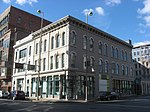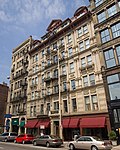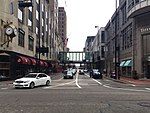The Greater Cincinnati Chamber of Commerce, doing business as the Cincinnati USA Regional Chamber, is a regional chamber of commerce. It is one of the nation's largest chambers of commerce, representing 4,000 businesses and nearly over 500,000 employees in southwestern Ohio, northern Kentucky and southeastern Indiana, also known as Greater Cincinnati, or the Cincinnati–Northern Kentucky metropolitan area. An award-winning membership organization, the Chamber has been recognized as national Chamber of the Year twice.
The Cincinnati Chamber of Commerce was founded October 15, 1839, by 76 firms and private individuals who placed an ad in the Cincinnati Daily Gazette urging local businessmen to attend a meeting at the Young Men's Mercantile Library Association headquarters in the old Cincinnati College Building at Fourth and Walnut Streets. This Chamber's founding preceded the United States Chamber of Commerce, which held its first meeting in Cincinnati, by 73 years. The Chamber celebrated its 175 Anniversary in 2014.
The Cincinnati Chamber of Commerce met in six different temporary locations until in 1876 they began the process that led to a permanent structure. The Chamber's Board of Real Estate Managers invited six architects to compete in a selection competition. Henry Hobson Richardson's design won and that building was erected in 1889. A fire in 1911 caused substantial damage to the building, leading to the discovery that only $90,000 of insurance was carried on the building, which had cost $772,674.05 to build, and so it could not be repaired. When the property was sold, much of the granite from the building was saved and stored in Oakley, Ohio. In 1967, Professor John Peterson at UC's University of Cincinnati College of Design, Architecture, Art, and Planning coordinated an effort to build a memorial to Henry Hobson Richardson out of the surviving stones. A design competition whose jury included's Richardson's grandson was held in 1968 and the design by student Stephen Carter (architect) was selected. The memorial was completed in 1972 and resides in Burnet Woods.
According to Charles Ludwig, a journalist in the 1920s and 1930s for the Cincinnati Times-Star, up to that time, the Chamber had been involved in most of the city's significant developments since its creation.
As Cincinnati grew and became an eight-county metropolitan area in the mid-1960s, the Chamber changed its name to the Greater Cincinnati Chamber of Commerce to reflect its regional representation of businesses throughout Southwestern Ohio, Northern Kentucky and Southeastern Indiana. It is now called The Cincinnati USA Regional Chamber. The phrase "Cincinnati USA" is used to indicate that Greater Cincinnati extends beyond just one U.S. city and state. Cincinnati USA is a region of 15 counties (In Ohio: Butler, Warren, Hamilton, Clermont and Brown Counties. In Kentucky: Boone, Kenton, Campbell, Gallatin, Grant, Pendleton and Bracken Counties. In Indiana: Franklin, Dearborn and Ohio Counties) located in three states (Ohio, Kentucky & Indiana).









